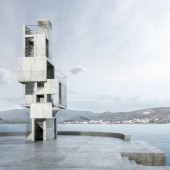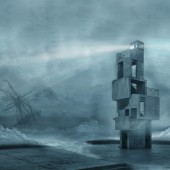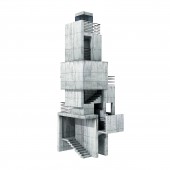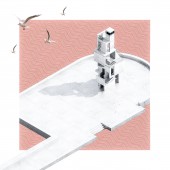
| THE AWARD |
| CATEGORIES |
| REGISTRATION |
| SUBMIT YOUR WORK |
| ENTRY INSTRUCTIONS |
| TERMS & CONDITIONS |
| PUBLICATIONS |
| DATES & FEES |
| METHODOLOGY |
| CONTACT |
| WINNERS |
| PRESS ROOM |
| GET INVOLVED |
| DESIGN PRIZE |
| DESIGN STORE |
| THE AWARD | JURY | CATEGORIES | REGISTRATION | PRESS | WINNERS | PUBLICATIONS | ENTRY INSTRUCTIONS |
Cubes Aleorion Lighthouse by Vasilis Mylonas |
Home > Winners > Design #126751 >Interview |
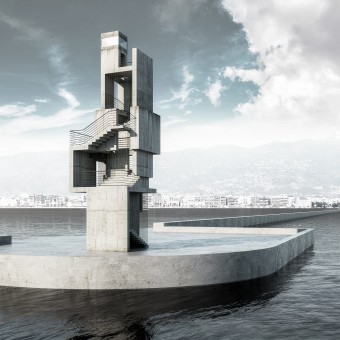 |
|
FS: What is the main principle, idea and inspiration behind your design?
VM: The project was inspired by the so called Aleorion of Xerxes, built around 480 BC and once stood on the reef Lefteris of the Aegean Sea, Greece. It is considered as the most ancient maritime safety structure in the world, built 250 years before the Lighthouse of Alexandria. The Dolomite stones, used for the construction of the lighthouse were placed on top of each other forming a tower that functioned as a warning sign of the reef and the nearby very shallow waters. The idea and the main principle of Cubes Aleorion was to create a modern interpretation of the aleorion and to transcribe the essence of the ancient structure to a modern landmark tower.
FS: What has been your main focus in designing this work? Especially what did you want to achieve?
VM: The main focus in designing Cubes Aleorion was to create a piece of architecture that could both remotely resonate instances of ancient maritime architecture and the same time echo the materiality, the form aesthetics of the modern urban environment of today and the long history roots of the city and the port itself, as well as the character of a maritime nation sailing the Mediterranean for thousand of years.
FS: What are your future plans for this award winning design?
VM: Cubes Aleorion Lighthouse is proposal for a landmark structure for the port entrance of the city of Volos, Greece. Speaking from the architect's point of view, there can't be any real future plans for a concept project that has already been delivered to public audience. It is entirely up to the citizens of the city and the competent authorities if such a project would be a meaningful and valuable addition to the urban landscape of the city.
FS: How long did it take you to design this particular concept?
VM: Including research, tons of drafts and concepts designs, the actual designing process and final renderings and presentations, I would say about 7-8 months.
FS: Why did you design this particular concept? Was this design commissioned or did you decide to pursuit an inspiration?
VM: No, the design was not commissioned by anyone. It was a personal humble attempt for a contribution to the urban environment of the city I live and work in.
FS: Is your design being produced or used by another company, or do you plan to sell or lease the production rights or do you intent to produce your work yourself?
VM: No, Cubes Aleorion is not for sale. It is just a personal proposal for the port and the city of Volos, Greece and it is entirely up to the citizens of the city and the competent authorities if such a project would be a meaningful addition to the urban landscape of the city.
FS: What made you design this particular type of work?
VM: The absence of a modern lighthouse structure at the end of the 1 km long breakwater of the city port of Volos, as well as the belief that such a structure could act as local landmark.
FS: Where there any other designs and/or designers that helped the influence the design of your work?
VM: Definitely. The guidance, advising and critique of architects Theoklis Kanarelis and Konstantinos Manolidis was invaluable, to say the least.
FS: Who is the target customer for his design?
VM: There are no customers for Cubes Aleorion. It is an attempt for a small contribution to the public architecture of the city.
FS: What sets this design apart from other similar or resembling concepts?
VM: That is not up to me to say.
FS: How did you come up with the name for this design? What does it mean?
VM: The name comes from the ancient greek word, dating back to the age of Homer, "Aleorion" [etym. < anc. Greek: ἀλεωρή “avoidance, to avoid”] meaning a navigation mark to show reefs or other hazards.
FS: Which design tools did you use when you were working on this project?
VM: Lots of pens and drafting paper, professional cad and rendering software, balsa wood for physical modeling and maquette.
FS: What is the most unique aspect of your design?
VM: Each level of Cubes Aleorion frames a different viewpoint of the bay, thus creating new perspectives of the city, the port, the sea and opposite coast of the Pagasetic Gulf. The casual walk on the paved breakwater is enriched with a new end-destination, encouraging the extension of the city waterfront promenade onto the sea.
FS: What is the role of technology in this particular design?
VM: The intention was to leverage simple and well established technology. And that is pre-cast reinforced concrete and metal detailing.
FS: What are some of the challenges you faced during the design/realization of your concept?
VM: The real challenge was to create an architectural form that respects various factors at the same time, such the landmark position of the lighthouse at the entry of the city port, the materiality and aesthetics of the urban environment and the long history roots of the city and the port itself. Another challenge was to mange the height restrictions along with the need of an internal staircase and the aim of silhouette as slim and tall as possible.
FS: How did you decide to submit your design to an international design competition?
VM: Submitting to an international competition was a "test-drive" of an otherwise completed architectural proposal, with the purpose of getting an international feedback and point of view on a local project.
FS: What did you learn or how did you improve yourself during the designing of this work?
VM: Designing and exposing to a broader audience an architectural project of public interest, re-confirmed the obvious: Public interest projects are always (and should be) a matter of public evaluation and critique.
FS: Thank you for providing us with this opportunity to interview you.
A' Design Award and Competitions grants rights to press members and bloggers to use parts of this interview. This interview is provided as it is; DesignPRWire and A' Design Award and Competitions cannot be held responsible for the answers given by participating designers.
| SOCIAL |
| + Add to Likes / Favorites | Send to My Email | Comment | View Press-Release | Translations |
